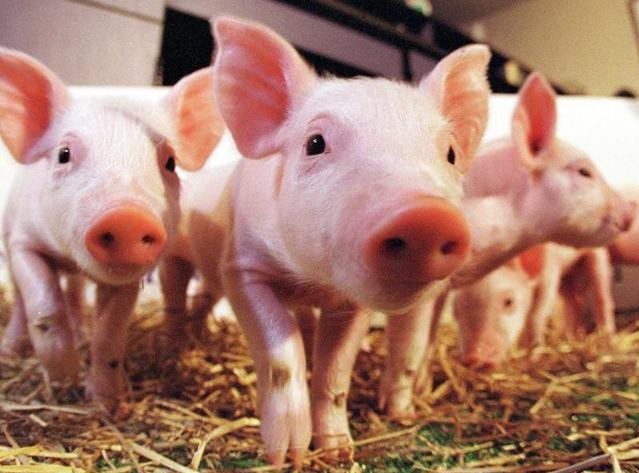Some pigs disease
PIG DISEASE

In principle diseases that attack pigs can be classified into two:
- Non-communicable diseases
For example diseases caused by deficiency of certain food substances (deficiency) such as anemia, hair loss, rachitis, poisoning, etc.
- Infectious diseases
Namely diseases caused by disorders of an organism (bacteria, viruses and parasites) such as worms, lice, etc.
Further below will be expressed some diseases, both non-infectious that usually befall and harm the business of pigs.
1.anemia (blood deficiency disease)
This disease is commonly experienced by small pigs, around the age of 3 weeks.
Cause:
· Usually iron and copper deficiency, where pigs no chance to get additional minerals from the soil.
· Pig mother milk only contain little iron.
Symptoms:
· Pale
· Diarrhea (diarrhea)
· Disturbed growth and lack of weight
· Pigs lay a lot and throw dirt around where they lie.
Prevention and treatment:
· Bunting pigs are fed with minerals that contain iron and copper.
· Piglets can be iron and copper by injection: for example pigdex, with dose:
a.prevention of piglets 2-4 days old 1cc per head
b. healing age 5-28 days 1-2 cc / tail given by way of intramuscular injection in the buttocks.
Note:
An acute anemia can lead to sudden death.
· Chronic may cause pigs suffer from scours (diarrhea)
2.agalactia
This disease is a parent-born pig disease which fails in removing or producing milk.
The cause: it is not always the same as other words and various causes:
· By Eshericho coli
· Because of intestinal toxicity due to contamination (unusual waste discharges), which is then followed by loss of appetite and sometimes hot to overcome constipation can be given a launcher, for example: English salt
· Due to inflammation of the uterus (metritis).the affected cattle sick loss of body temperature rise temperature: 106oF normal 102 - 1030F. From the vulva out the reddish or yellowish liquid.uterine inflammation is usually followed by inflammation of the udder (mastitis) resulting in milk failure (Agalactia), then this disease is also called MMA Complex (Mastitis Metritis Agalactia Complex).
Common symptoms:
• The first symptoms usually appear 3 days after delivery, although they often appear to have not given birth or before the children are weaned.
· Temperature 103 - 106oF.
· Pigs will not eat, milk a little or fail at all.
From the vagina out pus (pus) whitish or yellowish color.
· Piglets diarrhea.
· Sometimes unknown until the piglets are starving.
Prevention and treatment:
· Food is good, and cleanliness should be guaranteed
· To avoid constipation, pigs can be given launchers, or liquid sugar (sugar cane) 6-10%, on ration, salt english.
· Treatment, but not always effective: by injection of antibiotics (penicillin, penhilde, terramycin, sulmet)
Note:
· To stimulate breast milk can be injected with Oxytocin 5-10 I.U and 25 mg of stillbestrol.
· This event will befall all the piglets that give birth.therefore piglets should be given extra milk.
3.rheumatic
Cause:
Pigs lack sunlight, moist air, and poor ventilation are important factors.
· Food less good
· Livestock often suffers from Erysipelas.
Symptoms:
· Reduced appetite and weight loss
· Constipation, and urine somewhat turbid.
· Often show symptoms where pigs always lie and yell when pressed veins along the spine.
Prevention and treatment:
· Rations should be good, especially vitamin A and D enough.
· The cage is clean, warm and dry
· Treatment with penicillin injection and sulfa
4.scours (diarrhea)
Scours is a symptom of enteritis disease characterized by intestinal inflammation, scours attack many piglets or young pigs.
Cause:
To know the cause and the symptoms in particular is very difficult, because the scour actually there are various types of causes are not the same cause.but it is important to note that the accelerated scours or enteritis is due to poor sanitation, air humidity, cold, lack of cages, unqualified foods, lack of iron (anemia), stress.
Types of scours or enteritis:
Non Infectious Enteritis, this type of disease first arises from unsafe foods, especially vitamin B deficiency, resulting in scours.although these scours are not infectious (Non Infectious Scours) but greatly reduces the immune system that eventually enteritis enteritis infections and other diseases.
Infectious Enteritis
a. Nonspectious Enteritis
The disease is caused by various types of bacteria (not specifically by one of the bacteria), which has been infected due to stress.
b. Necrotic Enteritis; often called NECRO caused by Salmonella bacteria.
Many attack pigs aged 2-6 months
Dirt smells rotten, and colored rather grayish black
Dirt often mixed with intestinal tissues that have been released.
c. Dysentery
Namely scours that infected severely.sometimes these are called BLOODY or BLACK SCOURS, which are caused by the vibrio bacteria and can be from other bacteria (bacterial salmonella). These bacteria cause bloody diarrhea that is very dangerous or cause death.
d. Transmisible Gastro Enteritis (T.G.E)
Ie Enteritis disease caused by a virus.pigs in all ages can be attacked by TGE in young pigs deaths due to TGE can reach 100%.
Prevention and treatment:
Keeping the cage clean by using disinfectant (lysol, creolin, etc.) to spray and the cage is always dry.
· Against piglets, should always be given floor mats of grass, peat, sawdust, etc., which are always replaced to keep them warm and clean.
· Food is given TM 10 with a dose of 5-10 grams per 100 kg ration, or Aureomycin.
· Treatment with:
Sulmet injection; Aureomycin Soluble Powder in drinking water.
Aureomycin for 15 days (dose usually there is a clue from the company)
Other Antibiotics (Penstrep, Penicillin, Terramycin, Sul-Q-Nox, Noxal)
Note:
Stress: is the stress of the livestock that is very detrimental due to shock transport, cold, weaning, castration, vaccination, air change, or sudden food shifts.
Dose of Aureomycin:
a.prevention: 1 teaspoon Aureomycin Soluble Powder in 8 liters of drinking water.
b. Healing: 2 teaspoons Aureomycin Soluble Powder in 4 liters of drinking water.